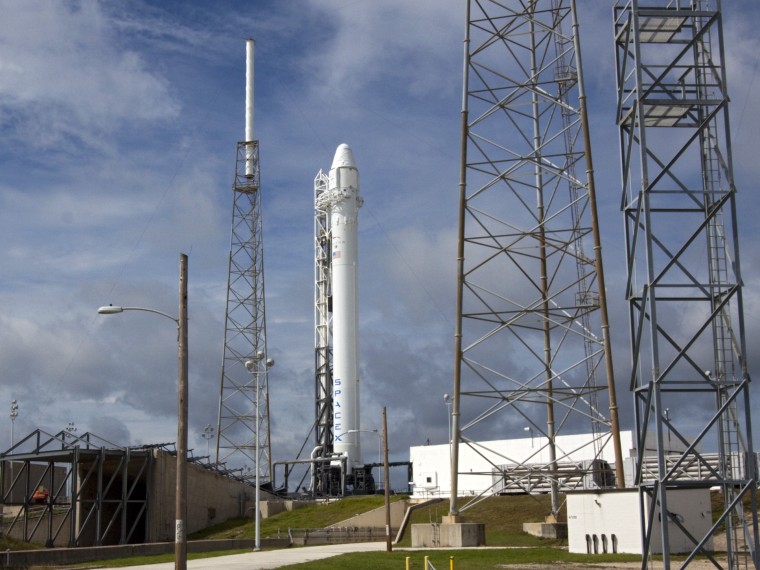A private company is on the verge of launching another cargo ship to the International Space Station.
On Sunday night, California-based SpaceX is due to send a Dragon capsule to the orbiting lab and its three-member crew.
Liftoff of the company's unmanned Falcon rocket is scheduled for 8:35 p.m. ET. Forecasters put the odds of acceptable weather at 60 percent. Thick clouds and rain are the main concerns.
A Dragon cargo ship successfully docked to the space station last May, but that was considered a test flight. The coming mission is the first under a $1.6 billion contract with NASA that calls for a dozen resupply flights by SpaceX, essential in the post-shuttle era.
"We got there once. We demonstrated we could do it, so there might be a teeny, teeny bit of relaxation. Not a lot, though," SpaceX President Gwynne Shotwell told reporters Saturday night.
NASA was monitoring a potentially threatening piece of orbiting junk, but said that even if the space station had to steer clear of the object, that would not delay the SpaceX mission.
This newest Dragon will haul about 1,000 pounds (450 kilograms) of food, clothes and gear, including ice cream for the American, Russian and Japanese astronauts on board. (The ice cream will go up in freezers meant for research). Even more cargo will be coming back.
The capsule will remain docked to the space station for most of October. Astronauts will fill the capsule with blood and urine samples, other experiments and old equipment, for its return to Earth at the end of the month. By then, the complex will be back to a full crew of six.
The nearly 500 tubes of blood and syringes of urine have been stashed in space station freezers since the last space shuttle flight, by Atlantis, in July 2011. The decommissioned Atlantis, and sister ships Discovery and Endeavour, are now museum relics.
NASA nutritionist Scott Smith said these blood and urine samples — part of medical studies — will be the first to be returned since Atlantis' final voyage.
"This is the first real return vehicle for this type of sample," Scott said.
The cargo ships periodically flown by Russia, Japan and Europe do not have the capability to return anything; they burn up upon re-entry. The SpaceX Dragon capsules parachute down into the Pacific for retrieval, reminiscent of NASA's old-time capsules.
"While it may seem very strange to some folks, my typical line is that, 'It may be urine to you, but it's gold to us,'" Smith said. "There's a lot of science that comes out of this."
NASA's space station program manager, Mike Suffredini, is also thrilled about having an American spacecraft bearing goods. It's much easier to get last-minute equipment aboard a U.S. capsule, he noted. The Dragon, for example, will carry up a new pump for the space station's urine-into-drinking water recycling system.
"Shipping and customs can kill you when you're trying to get overseas," Suffredini said.
SpaceX — or Space Exploration Technologies Corp. — is run by billionaire Elon Musk, a co-founder of PayPal who also directs the electric car maker Tesla Motors.
His space company is working to turn the unmanned Dragon vessels into craft that could carry Americans to the space station in the coming years. Until SpaceX or another U.S. company can do that, NASA astronauts will have to keep riding on Russian rockets at a steep cost.
SpaceX estimates it will be ready to launch crews aboard Dragons in three years.
NASA, meanwhile, expects to name within a few weeks the U.S. astronaut and Russian cosmonaut who will spend an entire year aboard the space station, beginning in spring 2015, twice the usual length for a mission. Suffredini said the list of potential candidates is "very short."
Another NASA official said only previous space station crew members are under consideration for the two slots because they're already trained in the systems of the orbiting complex.
On Friday, the space agency confirmed that it would commit to a yearlong mission to learn what it will take for humans to journey beyond low-Earth orbit — Mars, for example.
Russia already knows. Three cosmonauts spent at least a year aboard the old Mir space station; the record for a single stint is almost 15 months.
No American has spent more than seven months in space at a time.
